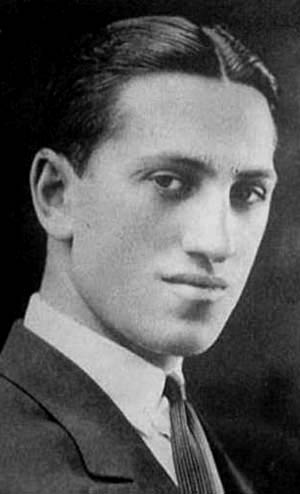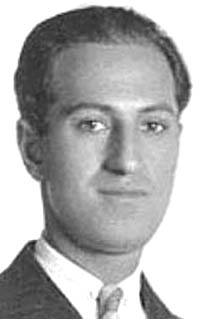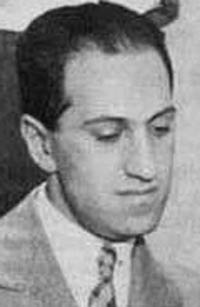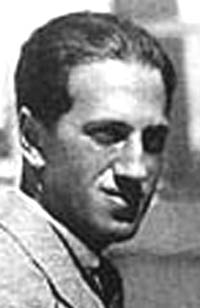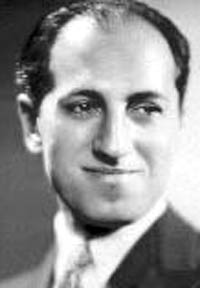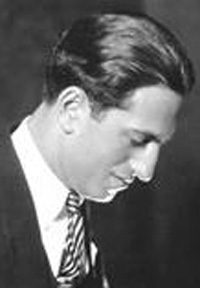Copyright Michael D. Robbins 2005
Astro-Rayological Interpretation & Charts
Quotes
Biography
Images and Physiognomic Interpretation
True music must repeat the thought and inspirations of the people and the time. My people are Americans and my time is today."
Why should I limit myself to only one woman when I can have as many women as I want?"
"True music . . . must repeat the thought and inspirations of the people and the time. My people are Americans. My time is today."
George Gershwin Born; Brooklyn, New York,
26 Sept 1898
Died; Hollywood, California,
11 July 1937
George Gershwin was born Jacob Gershowitz. His parents emigrated from Russia to the U.S.A in 1891. He first discovered music at age 10 at a friend's violin recital in a school auditorium in the lower East Side of Manhattan. George’s early interests were not in music, but sports. When a piano was brought into the Gershowitz home for brother Ira, George (age 12) was the one whose interest was sparked. After playing from memory a song he had heard on a neighbor's player piano, George’s parents invested in lessons.
By age 15 Gershwin had quit school and landed a job as pianist and "song plugger" for a Tin Pan Alley music-publishing firm, Jerome H. Remick & Company, at a salary of $15 a week.
To increase his income, Gershwin recorded piano rolls under various pen names. For his efforts he received $35 for six rolls. He was interested in both ‘serious’ and popular music, and composed in both styles. He was one of the first composers to combine jazz and classical music styles.
George was a great admirer of the comedian Ed Wynn and it is at this time, in honor of him, that Gershwin changed the end of his last name. He studied with the American composers Rubin Goldmark, Henry Cowell, and Wallingford Riegger and with the Russian-born composer and theorist Joseph Schillinger.
Gershwin wrote his first major successful musical work in 1924, Rhapsody in Blue. Asked by Paul Whiteman to write the work for a special concert of modern music to be presented at Aeolian Hall in New York, Gershwin finished his composition in less than three weeks. The speed of writing was due in part to George having forgotten about the commission. It was when Ira read in the newspaper of the upcoming concert that George’s remembered his musical commitment.
Much of his inspiration for the work came during a train ride to Boston. According to Gershwin, "with its steely rhythms, its rattlety-bang . . . I suddenly heard - and even saw on paper - the complete construction of the rhapsody from beginning to end. I heard it as a sort of musical kaleidoscope of America - of our vast melting pot, of our unduplicated national pep, of our blues, our metropolitan madness." The score was completed in a week upon his return to New York. The original setting was not for a large orchestra, but for a much smaller jazz ensemble. Gershwin himself performed at the piano at the world premiere.
The American composer Ferde Grofé, then a pianist and orchestrator for Paul Whiteman's Orchestra orchestrated Rhapsody in Blue. The success of Rhapsody in Blue led Gershwin to write more pieces for piano and orchestra including the Concerto in F, commissioned by famed conductor, Walter Damrosch. Gershwin followed this brilliant success with his 1928 tone poem An American in Paris, which takes the listener to the streets of Paris in the 1920s and calls for four traffic car horns in concert. To add authentic color to this work Gershwin visited Parisian garages and purchased used taxi horns that he incorporated into the score. Although he composed sketches of the work in Paris, it was completed on a farm in Connecticut. The piece premiered at Carnegie Hall December 13, 1928 and almost immediately transferred from the concert hall to the musical stage as it was incorporated into Show Girl as the ballet scene.
Gershwin had traveled to Paris in the hopes of studying with famed teacher Nadia Boulanger, but she refused him saying he was fine the way he was. Gershwin also sought to study with Igor Stravinsky. When he approached the composer at a party Stravinsky surprised him with the question "How much money do you make a year?" Upon hearing the answer Stravinsky replied, "Perhaps I should study with you, Mr. Gershwin."
The lyrics for nearly all of George Gershwin’s songs were written by his older brother, Ira. The song "Swanee," introduced by Al Jolson in Sinbad, became the greatest hit of Gershwin’s entire career. George and Ira followed this success with a constant flow of bright, up-tempo tunes and heartfelt ballads to became the dominant Broadway songwriters of the 1920’s.
This extraordinary collaboration led to a succession of 22 musical comedies. The Gershwin brothers’ musical Of Thee I Sing was the first musical to be awarded a Pulitzer Prize.
George & Ira
Gershwin’s greatest musical undertaking, Porgy and Bess, which was the first American opera, met with very little success when it initially opened.
It was set in the south and dealt with the poor of the ghettos and their daily lives. Gershwin, fascinated by the DuBose Heyward novel Porgy, recognised it as a perfect vehicle for opera using jazz and blues rhythms and idioms.
What he called a "folk opera," Porgy and Bess (co-written with DuBose and Dorothy Heyward and Ira Gershwin) was the Gershwin brothers’ most ambitious endeavor - the songs, orchestrations and drama all being of equal importance. Porgy and Bess was premiered on September 30, 1935 in Boston, and opened on Broadway on October 10. In addition to its 1942 and 1953 revivals and subsequent world tours, it was made into a major motion picture in 1959.
Cuban Overture (first titled Rumba) was George Gershwin's last attempt at a major serious orchestral success. He vacationed in Havana in 1932 and became very interested in the Cuban music, particularly the percussion. Gershwin always ahead of his time, premiered his overture well ahead of Xavier Cugat, who popularized music with Cuban rhythms.
Over the years, Gershwin songs have also been used in numerous films and musicals, including My One and Only (1983) and Crazy For You (1992). Crazy For You is loosely based on Girl Crazy, with a new libretto by Ken Ludwig and features several George and Ira songs, including two previously unpublished numbers. Gershwin’s music has been featured in movies such as When Harry Met Sally and Mr. Holland's Opus, and in the opening of the 1988 Olympics.
George Gershwin rarely made grand statements about his music. He described himself as a "modern romantic" and was quoted as saying, "true music … must reflect the thought and aspirations of the people and time. My people are Americans. My time is today."
"Popular songs and musical comedies as well jazz-flavored orchestral works and opera won international fame for the American composer George Gershwin (1898-1937). His parents were Russian-Jewish immigrants, and he grew up on the lower east side of Manhattan. As a boy, he taught himself to play hit tunes on a neighbor's piano; when he was thirteen, he began studying with a teacher who recognized his talent and introduced him to piano works ranging from Bach to Liszt to Debussy.
"At fifteen. he left school to become a pianist demonstrating new songs in the salesrooms of a music publisher; three years later, he started his won career as a songwriter, and in 1919 (at the age of twenty) he wrote La, La, Lucille, his first complete Broadway musical. The next year, his song Swanee was a tremendous hit; during the 1920s and 1930s he wrote one brilliant musical after another-including Lady, Be Good (1924), Funny Face (1927), and Of The I Sing (1931)--usually with his brother Ira as lyricist.
"Gershwin was not only a creator of the golden age of American musical theater but also a successful composer of music for the concert hall, beginning with the triumphant premiere of Rhapsody in Blue in 1924. He gave the first performance of his Concerto in F at Carnegie Hall in 1925 and traveled to Europe in the 1920s (meeting Berg in Vienna and Ravel and Stravinsky in Paris); part of his symphonic poem An American in Paris (1928) was composed on one of these visits. His most extended work is the opera Porgy and Bess (1935), which deals with the lives of poor black people in Charleston, South Carolina; it has been performed all over the world.
"Gershwin was outgoing, a sportsman, an art collector and amateur painter and irresistible to women; he was also wealthy, from royalties, concert fees, and his weekly radio show. During the last year of his life, he lived in Hollywood, were he wrote the music for several movies (and played tennis with Arnold Schoenberg in his spare time). He died of a brain tumor at the age of thirty-eight.
Rhapsody In Blue (1924)
"Rhapsody in Blue, Gershwin's most famous composition, is a one-movement work for piano and orchestra. The title reflects its free, rhapsodic form and blues flavor. But it is not true jazz, though it employs jazzlike rhythms and melodies and the orchestration suggests the distinctive sounds of jazz. There are three main sections and a coda; the extended piano solos in the main sections reflect Gershwin's own dazzling pianism and his genius as an improviser.
"Rhapsody in Blue opens with a now-famous clarinet solo that stars from a low trill, climbs the scale, and then slides up to a high 'wailing' tone. The blueslike opening theme, which grows out of the clarinet slide, is marked by the syncopations so typical of Gershwin's style."George Gershwin (September 26, 1898 – July 11, 1937) was an American composer. He was born Jacob Gershowitz in Brooklyn, New York to Russian Jewish immigrant parents. George made most of his works with his lyricist brother Ira Gershwin. Gershwin composed both for Broadway and for the classical concert hall. He also wrote popular songs with success. Many of his compositions have been used in cinema, and many are famous jazz standards; songbooks have been recorded by Ella Fitzgerald (memorable 3 discs recording for Verve, with Nelson Riddle's orchestra), Herbie Hancock and several other singers or players. In 1910, the Gershwins had acquired a piano for Ira's music lessons, but George took over, successfully playing by ear. He tried out various piano teachers for two years, then was introduced to Charles Hambitzer, who acted as George's mentor until Hambitzer's death in 1918. Hambitzer taught George conventional piano technique, introduced him to the music of the European masters, and encouraged him to attend orchestral concerts. (At home following such concerts, young George would attempt to reproduce at the keyboard the music he had heard). He later studied with classical composer Rubin Goldmark.
His 1916 novelty rag 'Rialto Ripples' was a commercial success, and in 1918 he scored his first big national hit with his song 'Swanee'.
In 1924, George and Ira collaborated on a musical comedy, Lady Be Good. It included standards as 'Fascinating Rhythm' and 'The Man I Love.' This was followed by Oh, Kay! (1926); Funny Face in (1927); Strike Up the Band (1927 & 1930); Girl Crazy (1930), which introduced the standard 'I Got Rhythm'; and Of Thee I Sing (1931), the first musical comedy to win a Pulitzer Prize.
It was in Hollywood, while working on the score of The Goldwyn Follies, that George Gershwin collapsed and, on July 11, 1937, died of a brain tumour. He was interred in the Westchester Hills Cemetery, Hastings-on-Hudson, New York.
Gershwin had a ten-year affair with composer Kay Swift. Swift was a frequent consult of Gershwin; he named the musical Oh, Kay after her. Posthumously, Swift arranged some of his music, transcribed some of his recordings, and collaborated with Ira on several projects.
The Gershwin estate continues to bring in significant royalties from licensing the copyrights on Gershwin's work. The estate supported the Sonny Bono Copyright Term Extension Act because its 1923 cutoff date was shortly before Gershwin had begun to create his most popular works. The copyrights on those works expire in 2007 in the European Union and between 2019 and 2027 in the United States of America.Musical style and influence
Gershwin was influenced very much by French composers of the early twentieth century. Upon meeting composer Maurice Ravel, Gershwin asked him of the possibility of becoming a student of composition under the master. Ravel is said to have replied, 'Why should you be a second-rate Ravel when you can be a first-rate Gershwin?' Ravel was already quite impressed with the ability of Gershwin, commenting, 'Personally I find jazz most interesting: the rhythms, the way the melodies are handled, the melodies themselves. I have heard of George Gershwin's works and I find them intriguing.' (Mawer 42) The orchestrations in Gershwin's symphonic works often seem similar to those of Ravel; likewise, Ravel's two piano concertos evince an influence of Gershwin.
Gershwin's own Concerto in F was criticised as being strongly rooted in the work of Claude Debussy, more so than in the jazz style which was expected. The comparison didn't deter Gershwin from continuing to explore French styles. The title of An American in Paris reflects the very journey that he had consciously taken as a composer: 'The opening part will be developed in typical French style, in the manner of Debussy and the Six, though the tunes are original.' (Hyland 126)
Gershwin also was intrigued with the an eclectic set of works as those of Alban Berg, Shostakovich, Stravinsky, Milhaud and Schoenberg. Russian Joseph Schillinger's influence as his teacher of composition was substantial in providing him with a method to his composition. After the posthumous success of Porgy and Bess, Schillinger claimed he had a large and direct influence in overseeing the creation of the opera; Ira completely denied that his brother had any such assistance for this work. In analysis, Schillinger's student Vernon Duke found that while many of Gershwin's works certainly were reviewed by Schillinger, Porgy does not seem to be one of them. The indirect influence of his study with the teacher was apparent in the opera's even more clear orchestrations but it is characteristically Gershwin in ways that Schillinger would not have approved of. (Hyland 167)George Gershwin
George Gershwin (September 26, 1898 - July 11, 1937) was an American composer. He was born Jacob Gershowitz in Brooklyn, New York to Russian Jewish immigrant parents.
Gershwin composed both for Broadway and for the classical concert hall, and his music contains elements of both. He also wrote popular songs with success. Many of his compositions have been used in cinema, and perhaps many more are famous jazz standards: songbooks have been recorded by Ella Fitzgerald (memorable 3 discs recording for Verve, with Nelson Riddle's orchestra), Herbie Hancock and several other singers or players.
George made most of his works with his brother Ira Gershwin, a lyricist. In 1910, the Gershwins had acquired a piano for Ira's music lessons, but George took over, successfully playing by ear. He tried out various piano teachers for 2 years, then was introduced to Charles Hambitzer - who became his mentor (and would remain so until Hambitzer's death in 1918). Hambitzer taught George conventional piano technique, introduced him to the European masters, and encouraged him to attend orchestral concerts (at home following such concerts, young George would attempt to reproduce at the keyboard the music he had heard). He later studied with classical composer Rubin Goldmark. His 1916 novelty rag "Rialto Ripples" was a commercial success, and in 1918 he scored his first big national hit with his song "Swanee".
In 1924, George and Ira collaborated on a musical comedy, "Lady Be Good". It included standards as "Fascinating Rhythm" and "The Man I Love." This was followed by "Oh, Kay!" (1926); "Funny Face" in (1927); "Strike Up the Band" (1927 & 1930); "Girl Crazy" (1930), which introduced the standard "I Got Rhythm"; and "Of Thee I Sing" (1931), the first musical comedy to win a Pulitzer Prize.
It was in Hollywood, while working on the score of The Goldwyn Follies, that George Gershwin collapsed and, on July 11, 1937, died of a brain tumour. He was interred in the Westchester Hills Cemetery, Hastings-on-Hudson, New York.
The Gershwin estate continues to bring in significant royalties from licensing the copyrights on Gershwin's work. The estate supported the Sonny Bono Copyright Term Extension Act because its 1923 cutoff date was shortly before Gershwin had begun to create his most popular works.
The copyrights on those works expire in 2007 in the European Union and between 2019 and 2027 in the United States of America.

